Influence of Technology and Globalization on Organizational Behavior 2
VerifiedAdded on 2022/10/08
|10
|2796
|15
Essay
AI Summary
This essay delves into the transformative effects of technology and globalization on organizational behavior. It examines how these forces reshape industry locations, the working environment, and the labor force. The study investigates the influence of economic globalization on employment within organizations and highlights the importance of technological components for the workforce, providing examples like autonomous mining and the rise of AI. The discussion covers the changing nature of work, driven by technological advances, recession, and new labor expectations. The essay also analyzes the global distribution of technological innovation, the impact on business activities, and the potential for job displacement due to automation. Furthermore, it explores the positive aspects of globalization, such as increased competition and knowledge sharing, and the need for workforce adaptation through training and lifelong learning. Finally, the essay addresses the various impacts of economic globalization on employment, job composition, earnings, and organizational management practices, concluding with the idea that while there are negative impacts, the positive influences tend to dominate with proper planning and implementation.
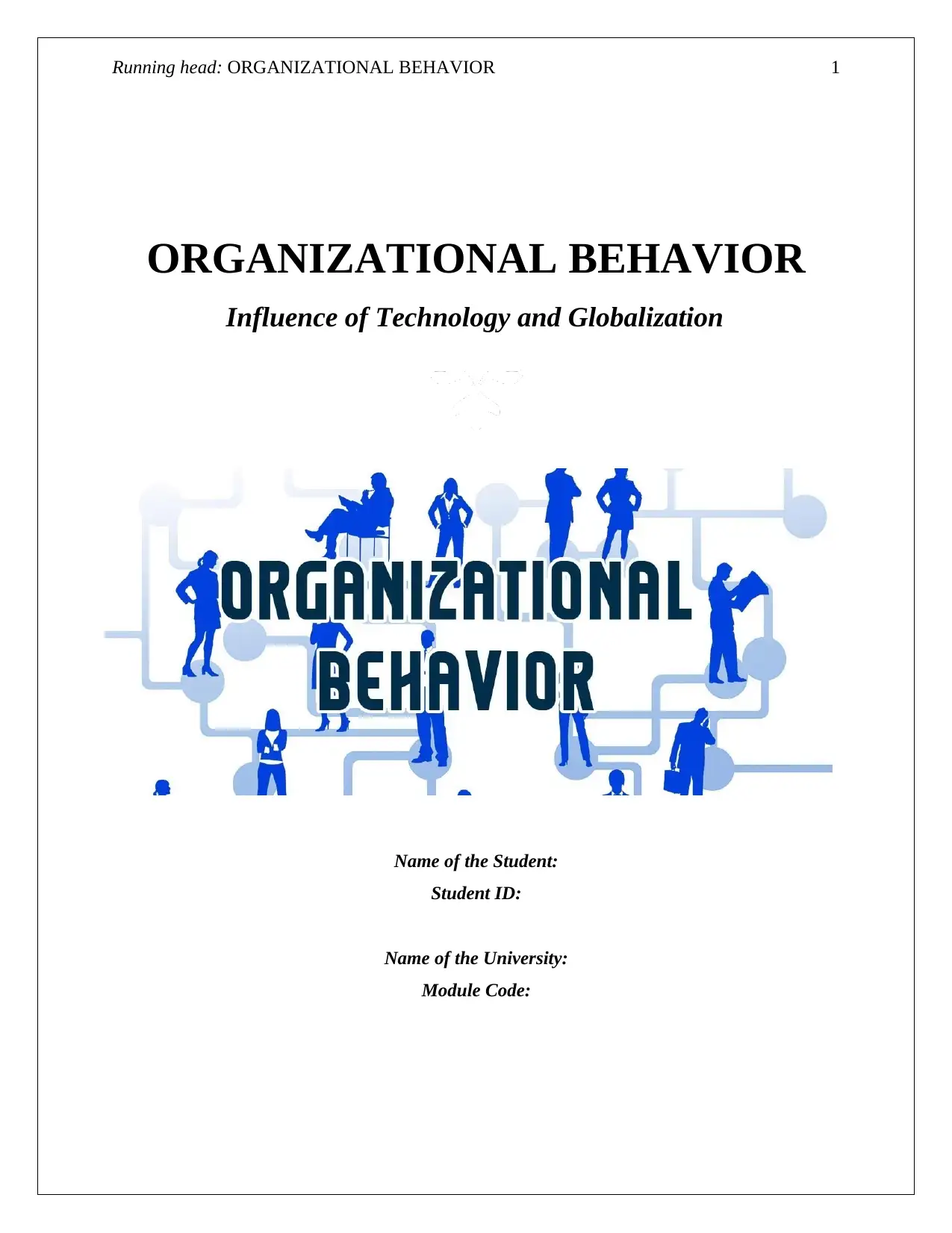
Running head: ORGANIZATIONAL BEHAVIOR 1
ORGANIZATIONAL BEHAVIOR
Influence of Technology and Globalization
Name of the Student:
Student ID:
Name of the University:
Module Code:
ORGANIZATIONAL BEHAVIOR
Influence of Technology and Globalization
Name of the Student:
Student ID:
Name of the University:
Module Code:
Paraphrase This Document
Need a fresh take? Get an instant paraphrase of this document with our AI Paraphraser
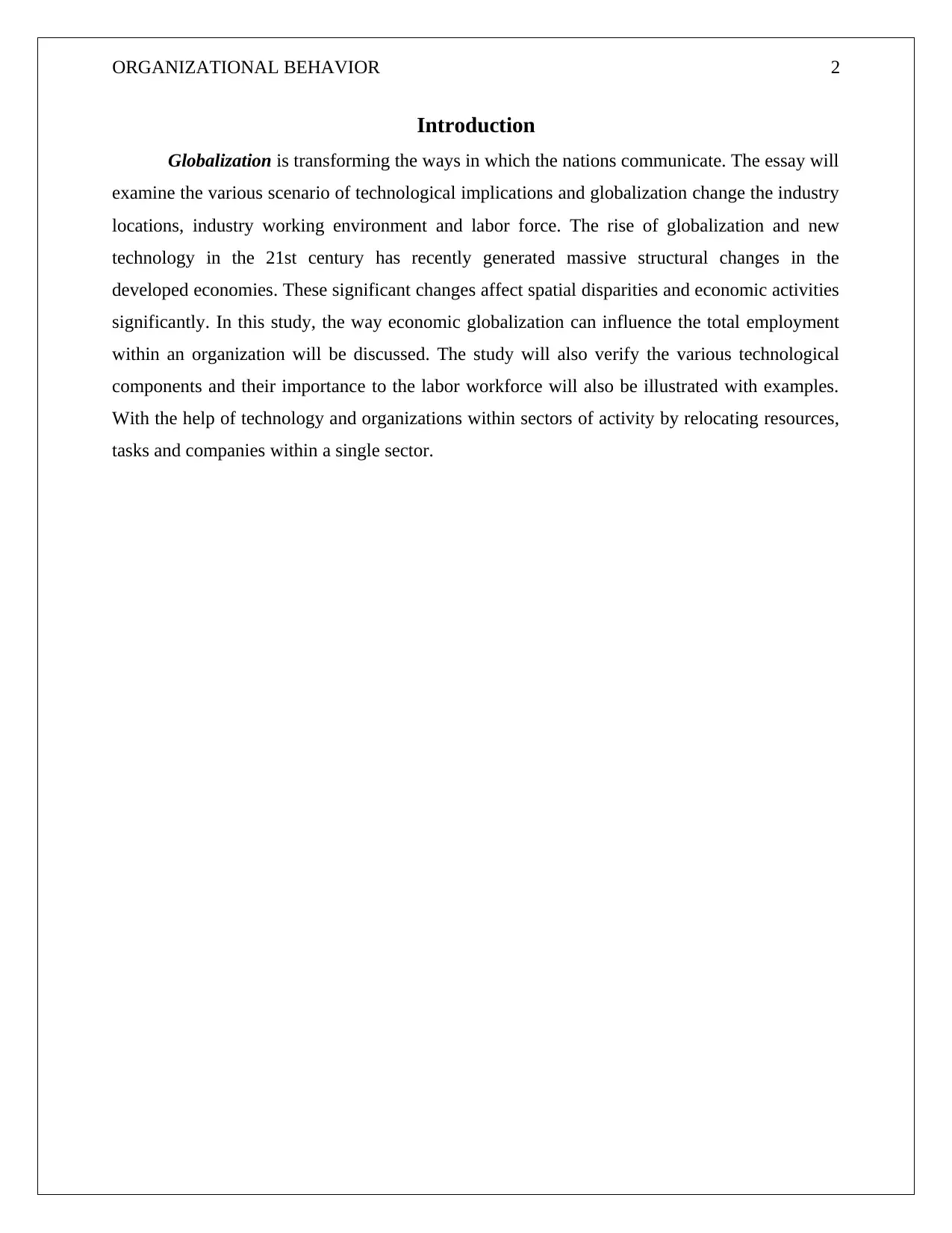
ORGANIZATIONAL BEHAVIOR 2
Introduction
Globalization is transforming the ways in which the nations communicate. The essay will
examine the various scenario of technological implications and globalization change the industry
locations, industry working environment and labor force. The rise of globalization and new
technology in the 21st century has recently generated massive structural changes in the
developed economies. These significant changes affect spatial disparities and economic activities
significantly. In this study, the way economic globalization can influence the total employment
within an organization will be discussed. The study will also verify the various technological
components and their importance to the labor workforce will also be illustrated with examples.
With the help of technology and organizations within sectors of activity by relocating resources,
tasks and companies within a single sector.
Introduction
Globalization is transforming the ways in which the nations communicate. The essay will
examine the various scenario of technological implications and globalization change the industry
locations, industry working environment and labor force. The rise of globalization and new
technology in the 21st century has recently generated massive structural changes in the
developed economies. These significant changes affect spatial disparities and economic activities
significantly. In this study, the way economic globalization can influence the total employment
within an organization will be discussed. The study will also verify the various technological
components and their importance to the labor workforce will also be illustrated with examples.
With the help of technology and organizations within sectors of activity by relocating resources,
tasks and companies within a single sector.
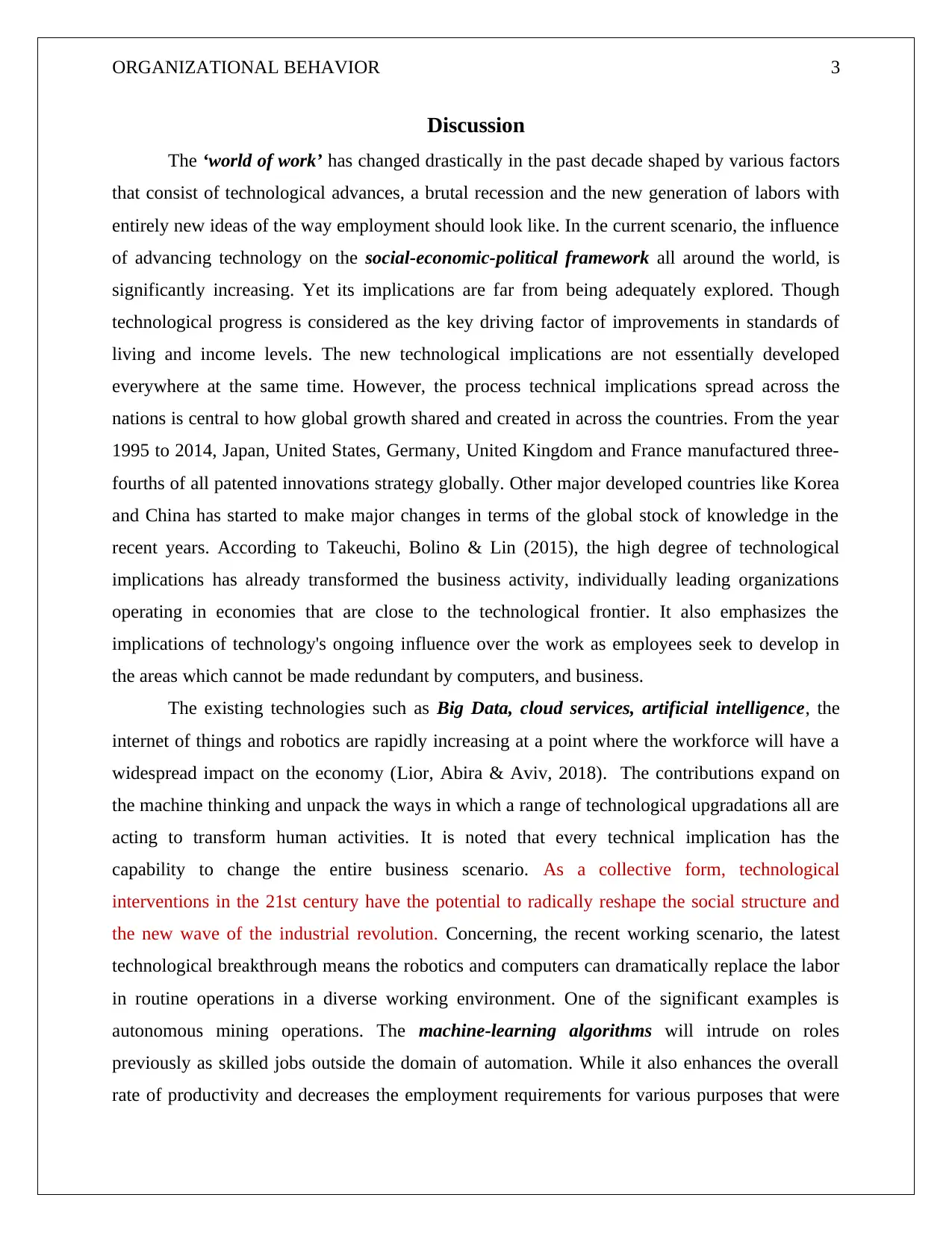
ORGANIZATIONAL BEHAVIOR 3
Discussion
The ‘world of work’ has changed drastically in the past decade shaped by various factors
that consist of technological advances, a brutal recession and the new generation of labors with
entirely new ideas of the way employment should look like. In the current scenario, the influence
of advancing technology on the social-economic-political framework all around the world, is
significantly increasing. Yet its implications are far from being adequately explored. Though
technological progress is considered as the key driving factor of improvements in standards of
living and income levels. The new technological implications are not essentially developed
everywhere at the same time. However, the process technical implications spread across the
nations is central to how global growth shared and created in across the countries. From the year
1995 to 2014, Japan, United States, Germany, United Kingdom and France manufactured three-
fourths of all patented innovations strategy globally. Other major developed countries like Korea
and China has started to make major changes in terms of the global stock of knowledge in the
recent years. According to Takeuchi, Bolino & Lin (2015), the high degree of technological
implications has already transformed the business activity, individually leading organizations
operating in economies that are close to the technological frontier. It also emphasizes the
implications of technology's ongoing influence over the work as employees seek to develop in
the areas which cannot be made redundant by computers, and business.
The existing technologies such as Big Data, cloud services, artificial intelligence, the
internet of things and robotics are rapidly increasing at a point where the workforce will have a
widespread impact on the economy (Lior, Abira & Aviv, 2018). The contributions expand on
the machine thinking and unpack the ways in which a range of technological upgradations all are
acting to transform human activities. It is noted that every technical implication has the
capability to change the entire business scenario. As a collective form, technological
interventions in the 21st century have the potential to radically reshape the social structure and
the new wave of the industrial revolution. Concerning, the recent working scenario, the latest
technological breakthrough means the robotics and computers can dramatically replace the labor
in routine operations in a diverse working environment. One of the significant examples is
autonomous mining operations. The machine-learning algorithms will intrude on roles
previously as skilled jobs outside the domain of automation. While it also enhances the overall
rate of productivity and decreases the employment requirements for various purposes that were
Discussion
The ‘world of work’ has changed drastically in the past decade shaped by various factors
that consist of technological advances, a brutal recession and the new generation of labors with
entirely new ideas of the way employment should look like. In the current scenario, the influence
of advancing technology on the social-economic-political framework all around the world, is
significantly increasing. Yet its implications are far from being adequately explored. Though
technological progress is considered as the key driving factor of improvements in standards of
living and income levels. The new technological implications are not essentially developed
everywhere at the same time. However, the process technical implications spread across the
nations is central to how global growth shared and created in across the countries. From the year
1995 to 2014, Japan, United States, Germany, United Kingdom and France manufactured three-
fourths of all patented innovations strategy globally. Other major developed countries like Korea
and China has started to make major changes in terms of the global stock of knowledge in the
recent years. According to Takeuchi, Bolino & Lin (2015), the high degree of technological
implications has already transformed the business activity, individually leading organizations
operating in economies that are close to the technological frontier. It also emphasizes the
implications of technology's ongoing influence over the work as employees seek to develop in
the areas which cannot be made redundant by computers, and business.
The existing technologies such as Big Data, cloud services, artificial intelligence, the
internet of things and robotics are rapidly increasing at a point where the workforce will have a
widespread impact on the economy (Lior, Abira & Aviv, 2018). The contributions expand on
the machine thinking and unpack the ways in which a range of technological upgradations all are
acting to transform human activities. It is noted that every technical implication has the
capability to change the entire business scenario. As a collective form, technological
interventions in the 21st century have the potential to radically reshape the social structure and
the new wave of the industrial revolution. Concerning, the recent working scenario, the latest
technological breakthrough means the robotics and computers can dramatically replace the labor
in routine operations in a diverse working environment. One of the significant examples is
autonomous mining operations. The machine-learning algorithms will intrude on roles
previously as skilled jobs outside the domain of automation. While it also enhances the overall
rate of productivity and decreases the employment requirements for various purposes that were
⊘ This is a preview!⊘
Do you want full access?
Subscribe today to unlock all pages.

Trusted by 1+ million students worldwide
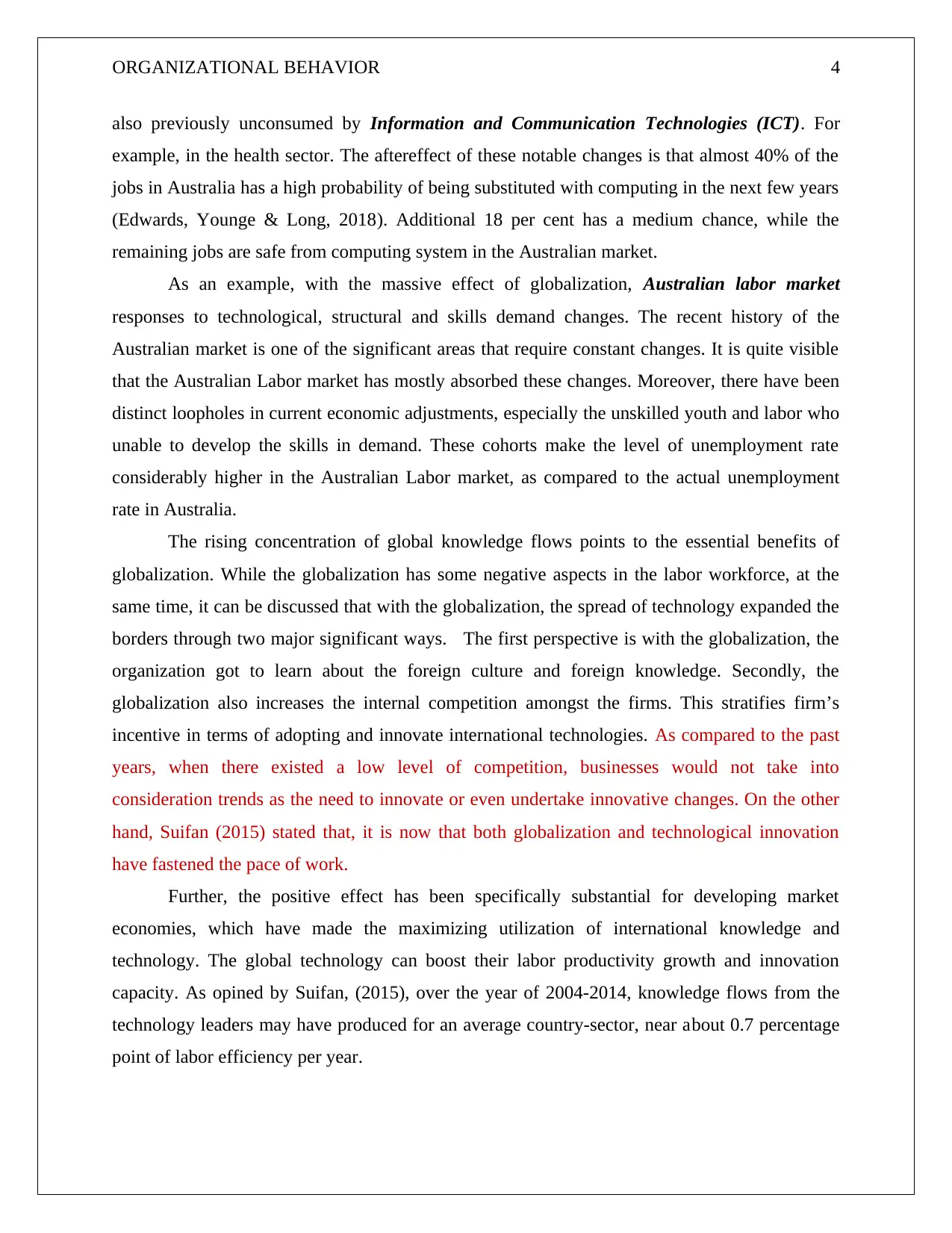
ORGANIZATIONAL BEHAVIOR 4
also previously unconsumed by Information and Communication Technologies (ICT). For
example, in the health sector. The aftereffect of these notable changes is that almost 40% of the
jobs in Australia has a high probability of being substituted with computing in the next few years
(Edwards, Younge & Long, 2018). Additional 18 per cent has a medium chance, while the
remaining jobs are safe from computing system in the Australian market.
As an example, with the massive effect of globalization, Australian labor market
responses to technological, structural and skills demand changes. The recent history of the
Australian market is one of the significant areas that require constant changes. It is quite visible
that the Australian Labor market has mostly absorbed these changes. Moreover, there have been
distinct loopholes in current economic adjustments, especially the unskilled youth and labor who
unable to develop the skills in demand. These cohorts make the level of unemployment rate
considerably higher in the Australian Labor market, as compared to the actual unemployment
rate in Australia.
The rising concentration of global knowledge flows points to the essential benefits of
globalization. While the globalization has some negative aspects in the labor workforce, at the
same time, it can be discussed that with the globalization, the spread of technology expanded the
borders through two major significant ways. The first perspective is with the globalization, the
organization got to learn about the foreign culture and foreign knowledge. Secondly, the
globalization also increases the internal competition amongst the firms. This stratifies firm’s
incentive in terms of adopting and innovate international technologies. As compared to the past
years, when there existed a low level of competition, businesses would not take into
consideration trends as the need to innovate or even undertake innovative changes. On the other
hand, Suifan (2015) stated that, it is now that both globalization and technological innovation
have fastened the pace of work.
Further, the positive effect has been specifically substantial for developing market
economies, which have made the maximizing utilization of international knowledge and
technology. The global technology can boost their labor productivity growth and innovation
capacity. As opined by Suifan, (2015), over the year of 2004-2014, knowledge flows from the
technology leaders may have produced for an average country-sector, near about 0.7 percentage
point of labor efficiency per year.
also previously unconsumed by Information and Communication Technologies (ICT). For
example, in the health sector. The aftereffect of these notable changes is that almost 40% of the
jobs in Australia has a high probability of being substituted with computing in the next few years
(Edwards, Younge & Long, 2018). Additional 18 per cent has a medium chance, while the
remaining jobs are safe from computing system in the Australian market.
As an example, with the massive effect of globalization, Australian labor market
responses to technological, structural and skills demand changes. The recent history of the
Australian market is one of the significant areas that require constant changes. It is quite visible
that the Australian Labor market has mostly absorbed these changes. Moreover, there have been
distinct loopholes in current economic adjustments, especially the unskilled youth and labor who
unable to develop the skills in demand. These cohorts make the level of unemployment rate
considerably higher in the Australian Labor market, as compared to the actual unemployment
rate in Australia.
The rising concentration of global knowledge flows points to the essential benefits of
globalization. While the globalization has some negative aspects in the labor workforce, at the
same time, it can be discussed that with the globalization, the spread of technology expanded the
borders through two major significant ways. The first perspective is with the globalization, the
organization got to learn about the foreign culture and foreign knowledge. Secondly, the
globalization also increases the internal competition amongst the firms. This stratifies firm’s
incentive in terms of adopting and innovate international technologies. As compared to the past
years, when there existed a low level of competition, businesses would not take into
consideration trends as the need to innovate or even undertake innovative changes. On the other
hand, Suifan (2015) stated that, it is now that both globalization and technological innovation
have fastened the pace of work.
Further, the positive effect has been specifically substantial for developing market
economies, which have made the maximizing utilization of international knowledge and
technology. The global technology can boost their labor productivity growth and innovation
capacity. As opined by Suifan, (2015), over the year of 2004-2014, knowledge flows from the
technology leaders may have produced for an average country-sector, near about 0.7 percentage
point of labor efficiency per year.
Paraphrase This Document
Need a fresh take? Get an instant paraphrase of this document with our AI Paraphraser
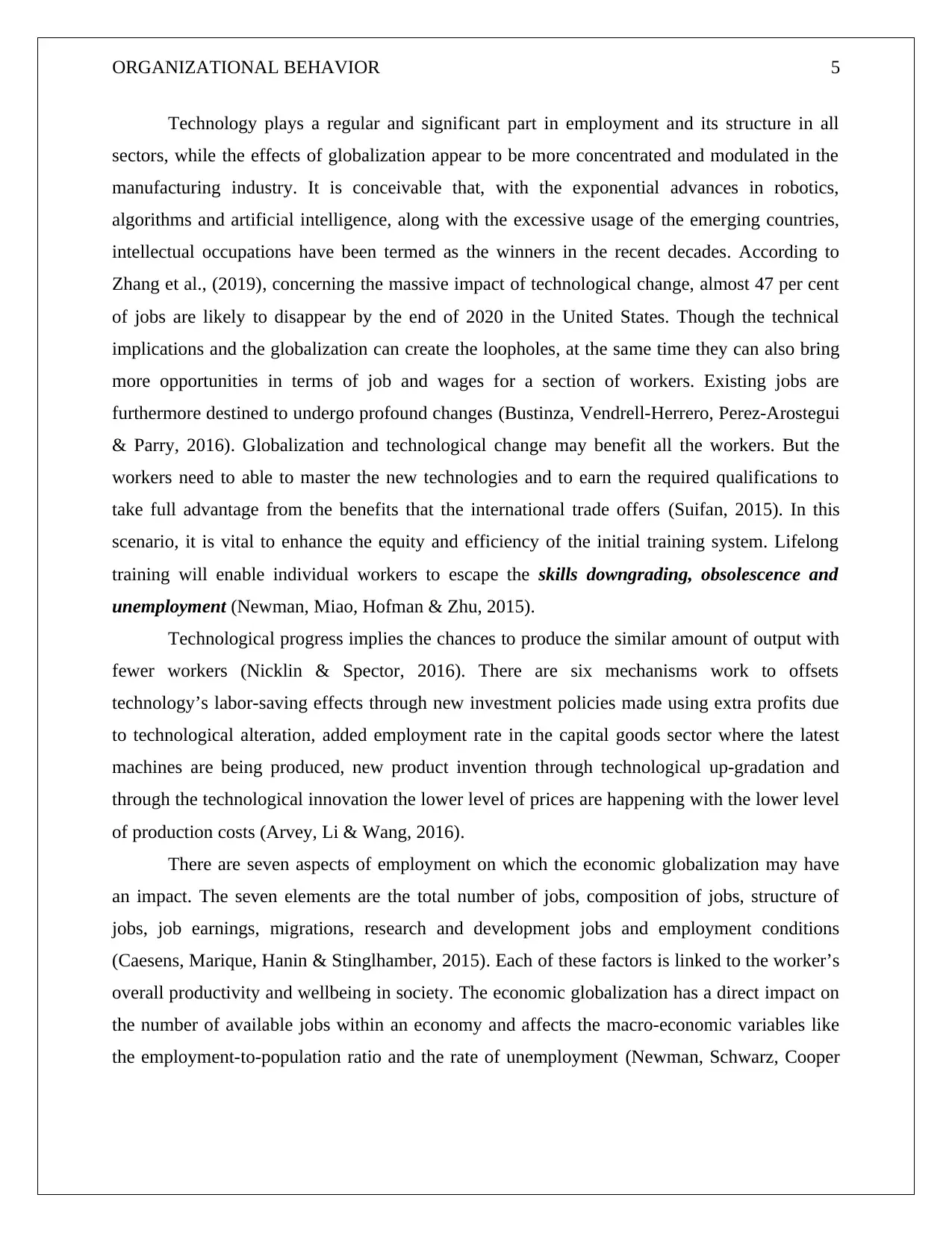
ORGANIZATIONAL BEHAVIOR 5
Technology plays a regular and significant part in employment and its structure in all
sectors, while the effects of globalization appear to be more concentrated and modulated in the
manufacturing industry. It is conceivable that, with the exponential advances in robotics,
algorithms and artificial intelligence, along with the excessive usage of the emerging countries,
intellectual occupations have been termed as the winners in the recent decades. According to
Zhang et al., (2019), concerning the massive impact of technological change, almost 47 per cent
of jobs are likely to disappear by the end of 2020 in the United States. Though the technical
implications and the globalization can create the loopholes, at the same time they can also bring
more opportunities in terms of job and wages for a section of workers. Existing jobs are
furthermore destined to undergo profound changes (Bustinza, Vendrell-Herrero, Perez-Arostegui
& Parry, 2016). Globalization and technological change may benefit all the workers. But the
workers need to able to master the new technologies and to earn the required qualifications to
take full advantage from the benefits that the international trade offers (Suifan, 2015). In this
scenario, it is vital to enhance the equity and efficiency of the initial training system. Lifelong
training will enable individual workers to escape the skills downgrading, obsolescence and
unemployment (Newman, Miao, Hofman & Zhu, 2015).
Technological progress implies the chances to produce the similar amount of output with
fewer workers (Nicklin & Spector, 2016). There are six mechanisms work to offsets
technology’s labor-saving effects through new investment policies made using extra profits due
to technological alteration, added employment rate in the capital goods sector where the latest
machines are being produced, new product invention through technological up-gradation and
through the technological innovation the lower level of prices are happening with the lower level
of production costs (Arvey, Li & Wang, 2016).
There are seven aspects of employment on which the economic globalization may have
an impact. The seven elements are the total number of jobs, composition of jobs, structure of
jobs, job earnings, migrations, research and development jobs and employment conditions
(Caesens, Marique, Hanin & Stinglhamber, 2015). Each of these factors is linked to the worker’s
overall productivity and wellbeing in society. The economic globalization has a direct impact on
the number of available jobs within an economy and affects the macro-economic variables like
the employment-to-population ratio and the rate of unemployment (Newman, Schwarz, Cooper
Technology plays a regular and significant part in employment and its structure in all
sectors, while the effects of globalization appear to be more concentrated and modulated in the
manufacturing industry. It is conceivable that, with the exponential advances in robotics,
algorithms and artificial intelligence, along with the excessive usage of the emerging countries,
intellectual occupations have been termed as the winners in the recent decades. According to
Zhang et al., (2019), concerning the massive impact of technological change, almost 47 per cent
of jobs are likely to disappear by the end of 2020 in the United States. Though the technical
implications and the globalization can create the loopholes, at the same time they can also bring
more opportunities in terms of job and wages for a section of workers. Existing jobs are
furthermore destined to undergo profound changes (Bustinza, Vendrell-Herrero, Perez-Arostegui
& Parry, 2016). Globalization and technological change may benefit all the workers. But the
workers need to able to master the new technologies and to earn the required qualifications to
take full advantage from the benefits that the international trade offers (Suifan, 2015). In this
scenario, it is vital to enhance the equity and efficiency of the initial training system. Lifelong
training will enable individual workers to escape the skills downgrading, obsolescence and
unemployment (Newman, Miao, Hofman & Zhu, 2015).
Technological progress implies the chances to produce the similar amount of output with
fewer workers (Nicklin & Spector, 2016). There are six mechanisms work to offsets
technology’s labor-saving effects through new investment policies made using extra profits due
to technological alteration, added employment rate in the capital goods sector where the latest
machines are being produced, new product invention through technological up-gradation and
through the technological innovation the lower level of prices are happening with the lower level
of production costs (Arvey, Li & Wang, 2016).
There are seven aspects of employment on which the economic globalization may have
an impact. The seven elements are the total number of jobs, composition of jobs, structure of
jobs, job earnings, migrations, research and development jobs and employment conditions
(Caesens, Marique, Hanin & Stinglhamber, 2015). Each of these factors is linked to the worker’s
overall productivity and wellbeing in society. The economic globalization has a direct impact on
the number of available jobs within an economy and affects the macro-economic variables like
the employment-to-population ratio and the rate of unemployment (Newman, Schwarz, Cooper
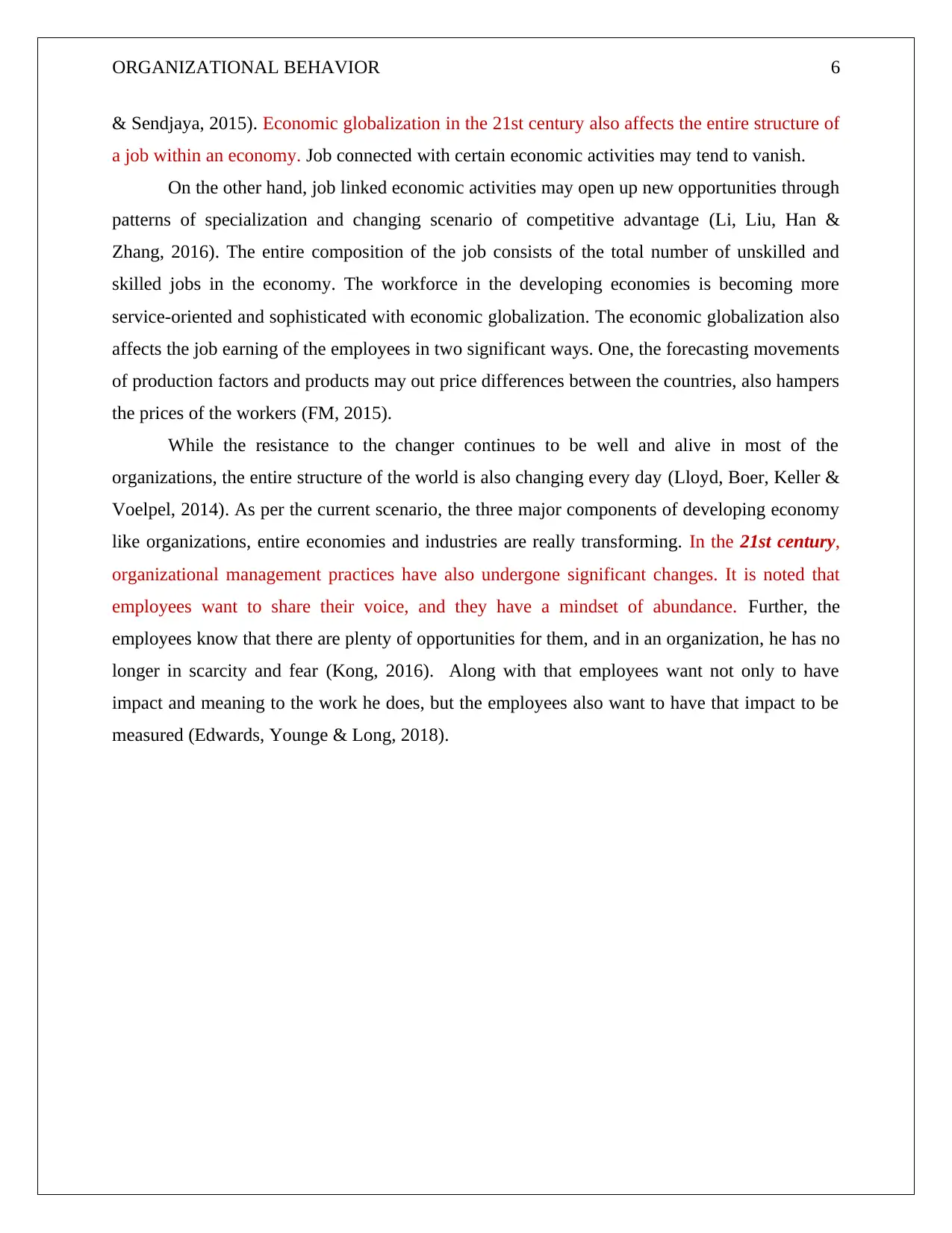
ORGANIZATIONAL BEHAVIOR 6
& Sendjaya, 2015). Economic globalization in the 21st century also affects the entire structure of
a job within an economy. Job connected with certain economic activities may tend to vanish.
On the other hand, job linked economic activities may open up new opportunities through
patterns of specialization and changing scenario of competitive advantage (Li, Liu, Han &
Zhang, 2016). The entire composition of the job consists of the total number of unskilled and
skilled jobs in the economy. The workforce in the developing economies is becoming more
service-oriented and sophisticated with economic globalization. The economic globalization also
affects the job earning of the employees in two significant ways. One, the forecasting movements
of production factors and products may out price differences between the countries, also hampers
the prices of the workers (FM, 2015).
While the resistance to the changer continues to be well and alive in most of the
organizations, the entire structure of the world is also changing every day (Lloyd, Boer, Keller &
Voelpel, 2014). As per the current scenario, the three major components of developing economy
like organizations, entire economies and industries are really transforming. In the 21st century,
organizational management practices have also undergone significant changes. It is noted that
employees want to share their voice, and they have a mindset of abundance. Further, the
employees know that there are plenty of opportunities for them, and in an organization, he has no
longer in scarcity and fear (Kong, 2016). Along with that employees want not only to have
impact and meaning to the work he does, but the employees also want to have that impact to be
measured (Edwards, Younge & Long, 2018).
& Sendjaya, 2015). Economic globalization in the 21st century also affects the entire structure of
a job within an economy. Job connected with certain economic activities may tend to vanish.
On the other hand, job linked economic activities may open up new opportunities through
patterns of specialization and changing scenario of competitive advantage (Li, Liu, Han &
Zhang, 2016). The entire composition of the job consists of the total number of unskilled and
skilled jobs in the economy. The workforce in the developing economies is becoming more
service-oriented and sophisticated with economic globalization. The economic globalization also
affects the job earning of the employees in two significant ways. One, the forecasting movements
of production factors and products may out price differences between the countries, also hampers
the prices of the workers (FM, 2015).
While the resistance to the changer continues to be well and alive in most of the
organizations, the entire structure of the world is also changing every day (Lloyd, Boer, Keller &
Voelpel, 2014). As per the current scenario, the three major components of developing economy
like organizations, entire economies and industries are really transforming. In the 21st century,
organizational management practices have also undergone significant changes. It is noted that
employees want to share their voice, and they have a mindset of abundance. Further, the
employees know that there are plenty of opportunities for them, and in an organization, he has no
longer in scarcity and fear (Kong, 2016). Along with that employees want not only to have
impact and meaning to the work he does, but the employees also want to have that impact to be
measured (Edwards, Younge & Long, 2018).
⊘ This is a preview!⊘
Do you want full access?
Subscribe today to unlock all pages.

Trusted by 1+ million students worldwide
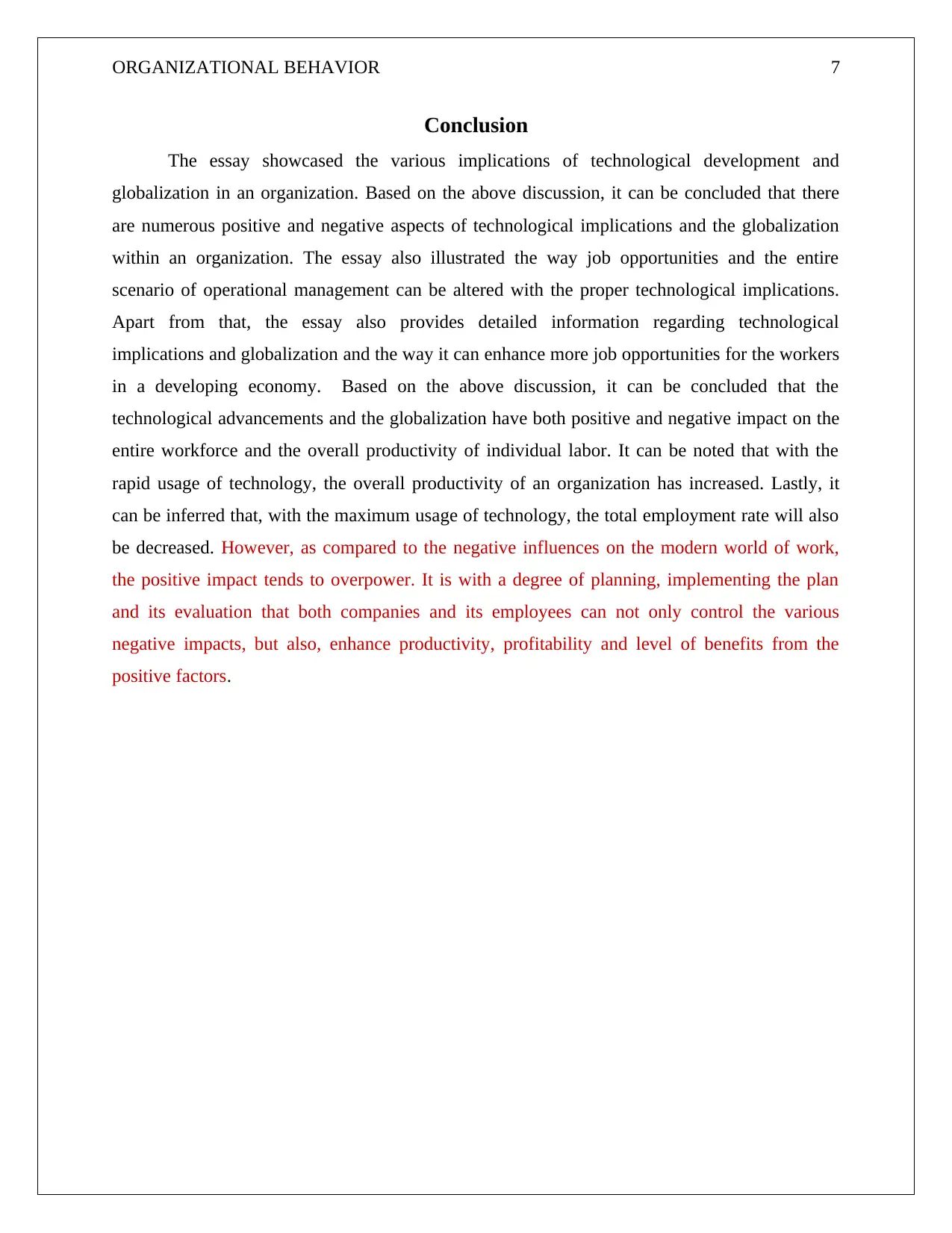
ORGANIZATIONAL BEHAVIOR 7
Conclusion
The essay showcased the various implications of technological development and
globalization in an organization. Based on the above discussion, it can be concluded that there
are numerous positive and negative aspects of technological implications and the globalization
within an organization. The essay also illustrated the way job opportunities and the entire
scenario of operational management can be altered with the proper technological implications.
Apart from that, the essay also provides detailed information regarding technological
implications and globalization and the way it can enhance more job opportunities for the workers
in a developing economy. Based on the above discussion, it can be concluded that the
technological advancements and the globalization have both positive and negative impact on the
entire workforce and the overall productivity of individual labor. It can be noted that with the
rapid usage of technology, the overall productivity of an organization has increased. Lastly, it
can be inferred that, with the maximum usage of technology, the total employment rate will also
be decreased. However, as compared to the negative influences on the modern world of work,
the positive impact tends to overpower. It is with a degree of planning, implementing the plan
and its evaluation that both companies and its employees can not only control the various
negative impacts, but also, enhance productivity, profitability and level of benefits from the
positive factors.
Conclusion
The essay showcased the various implications of technological development and
globalization in an organization. Based on the above discussion, it can be concluded that there
are numerous positive and negative aspects of technological implications and the globalization
within an organization. The essay also illustrated the way job opportunities and the entire
scenario of operational management can be altered with the proper technological implications.
Apart from that, the essay also provides detailed information regarding technological
implications and globalization and the way it can enhance more job opportunities for the workers
in a developing economy. Based on the above discussion, it can be concluded that the
technological advancements and the globalization have both positive and negative impact on the
entire workforce and the overall productivity of individual labor. It can be noted that with the
rapid usage of technology, the overall productivity of an organization has increased. Lastly, it
can be inferred that, with the maximum usage of technology, the total employment rate will also
be decreased. However, as compared to the negative influences on the modern world of work,
the positive impact tends to overpower. It is with a degree of planning, implementing the plan
and its evaluation that both companies and its employees can not only control the various
negative impacts, but also, enhance productivity, profitability and level of benefits from the
positive factors.
Paraphrase This Document
Need a fresh take? Get an instant paraphrase of this document with our AI Paraphraser
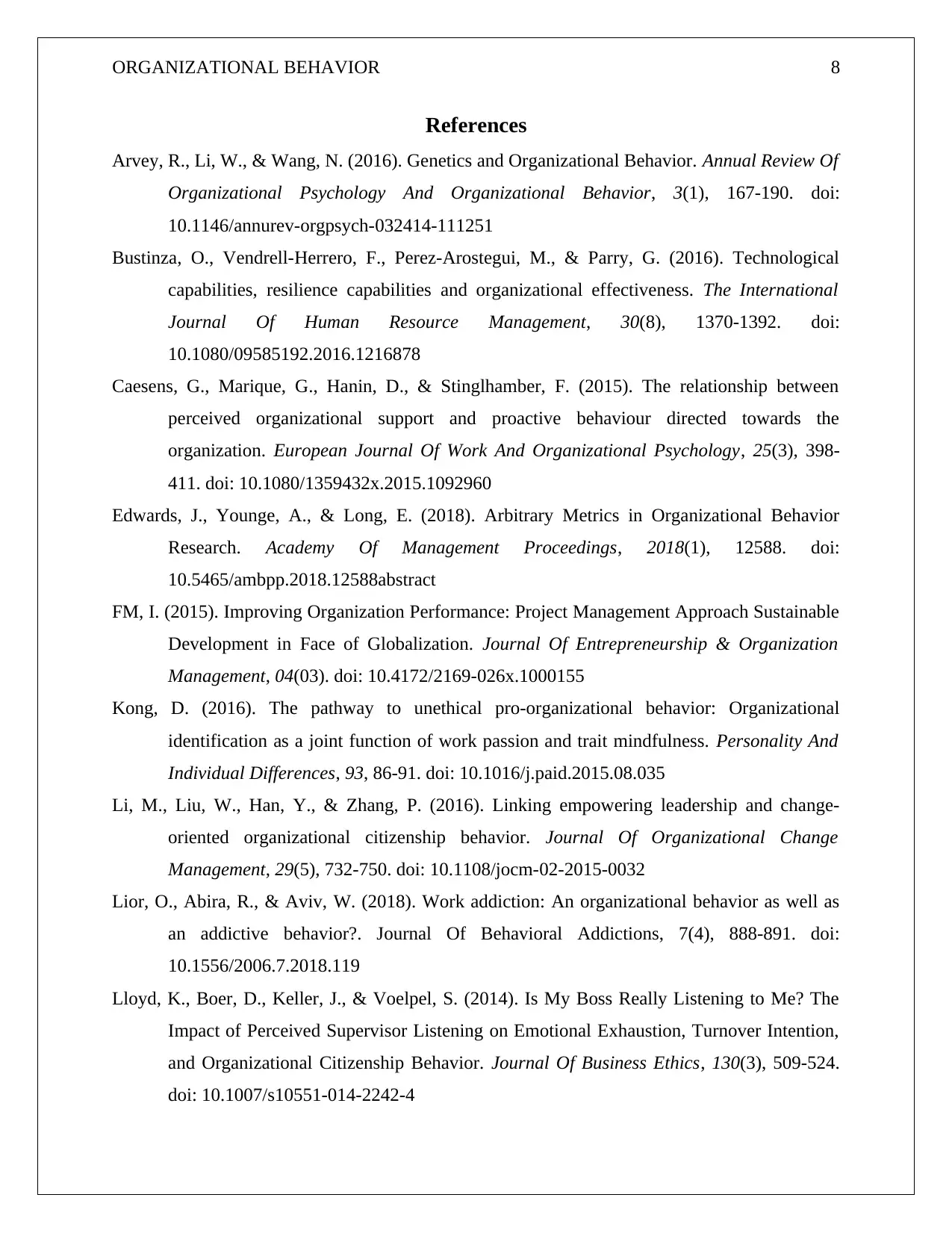
ORGANIZATIONAL BEHAVIOR 8
References
Arvey, R., Li, W., & Wang, N. (2016). Genetics and Organizational Behavior. Annual Review Of
Organizational Psychology And Organizational Behavior, 3(1), 167-190. doi:
10.1146/annurev-orgpsych-032414-111251
Bustinza, O., Vendrell-Herrero, F., Perez-Arostegui, M., & Parry, G. (2016). Technological
capabilities, resilience capabilities and organizational effectiveness. The International
Journal Of Human Resource Management, 30(8), 1370-1392. doi:
10.1080/09585192.2016.1216878
Caesens, G., Marique, G., Hanin, D., & Stinglhamber, F. (2015). The relationship between
perceived organizational support and proactive behaviour directed towards the
organization. European Journal Of Work And Organizational Psychology, 25(3), 398-
411. doi: 10.1080/1359432x.2015.1092960
Edwards, J., Younge, A., & Long, E. (2018). Arbitrary Metrics in Organizational Behavior
Research. Academy Of Management Proceedings, 2018(1), 12588. doi:
10.5465/ambpp.2018.12588abstract
FM, I. (2015). Improving Organization Performance: Project Management Approach Sustainable
Development in Face of Globalization. Journal Of Entrepreneurship & Organization
Management, 04(03). doi: 10.4172/2169-026x.1000155
Kong, D. (2016). The pathway to unethical pro-organizational behavior: Organizational
identification as a joint function of work passion and trait mindfulness. Personality And
Individual Differences, 93, 86-91. doi: 10.1016/j.paid.2015.08.035
Li, M., Liu, W., Han, Y., & Zhang, P. (2016). Linking empowering leadership and change-
oriented organizational citizenship behavior. Journal Of Organizational Change
Management, 29(5), 732-750. doi: 10.1108/jocm-02-2015-0032
Lior, O., Abira, R., & Aviv, W. (2018). Work addiction: An organizational behavior as well as
an addictive behavior?. Journal Of Behavioral Addictions, 7(4), 888-891. doi:
10.1556/2006.7.2018.119
Lloyd, K., Boer, D., Keller, J., & Voelpel, S. (2014). Is My Boss Really Listening to Me? The
Impact of Perceived Supervisor Listening on Emotional Exhaustion, Turnover Intention,
and Organizational Citizenship Behavior. Journal Of Business Ethics, 130(3), 509-524.
doi: 10.1007/s10551-014-2242-4
References
Arvey, R., Li, W., & Wang, N. (2016). Genetics and Organizational Behavior. Annual Review Of
Organizational Psychology And Organizational Behavior, 3(1), 167-190. doi:
10.1146/annurev-orgpsych-032414-111251
Bustinza, O., Vendrell-Herrero, F., Perez-Arostegui, M., & Parry, G. (2016). Technological
capabilities, resilience capabilities and organizational effectiveness. The International
Journal Of Human Resource Management, 30(8), 1370-1392. doi:
10.1080/09585192.2016.1216878
Caesens, G., Marique, G., Hanin, D., & Stinglhamber, F. (2015). The relationship between
perceived organizational support and proactive behaviour directed towards the
organization. European Journal Of Work And Organizational Psychology, 25(3), 398-
411. doi: 10.1080/1359432x.2015.1092960
Edwards, J., Younge, A., & Long, E. (2018). Arbitrary Metrics in Organizational Behavior
Research. Academy Of Management Proceedings, 2018(1), 12588. doi:
10.5465/ambpp.2018.12588abstract
FM, I. (2015). Improving Organization Performance: Project Management Approach Sustainable
Development in Face of Globalization. Journal Of Entrepreneurship & Organization
Management, 04(03). doi: 10.4172/2169-026x.1000155
Kong, D. (2016). The pathway to unethical pro-organizational behavior: Organizational
identification as a joint function of work passion and trait mindfulness. Personality And
Individual Differences, 93, 86-91. doi: 10.1016/j.paid.2015.08.035
Li, M., Liu, W., Han, Y., & Zhang, P. (2016). Linking empowering leadership and change-
oriented organizational citizenship behavior. Journal Of Organizational Change
Management, 29(5), 732-750. doi: 10.1108/jocm-02-2015-0032
Lior, O., Abira, R., & Aviv, W. (2018). Work addiction: An organizational behavior as well as
an addictive behavior?. Journal Of Behavioral Addictions, 7(4), 888-891. doi:
10.1556/2006.7.2018.119
Lloyd, K., Boer, D., Keller, J., & Voelpel, S. (2014). Is My Boss Really Listening to Me? The
Impact of Perceived Supervisor Listening on Emotional Exhaustion, Turnover Intention,
and Organizational Citizenship Behavior. Journal Of Business Ethics, 130(3), 509-524.
doi: 10.1007/s10551-014-2242-4
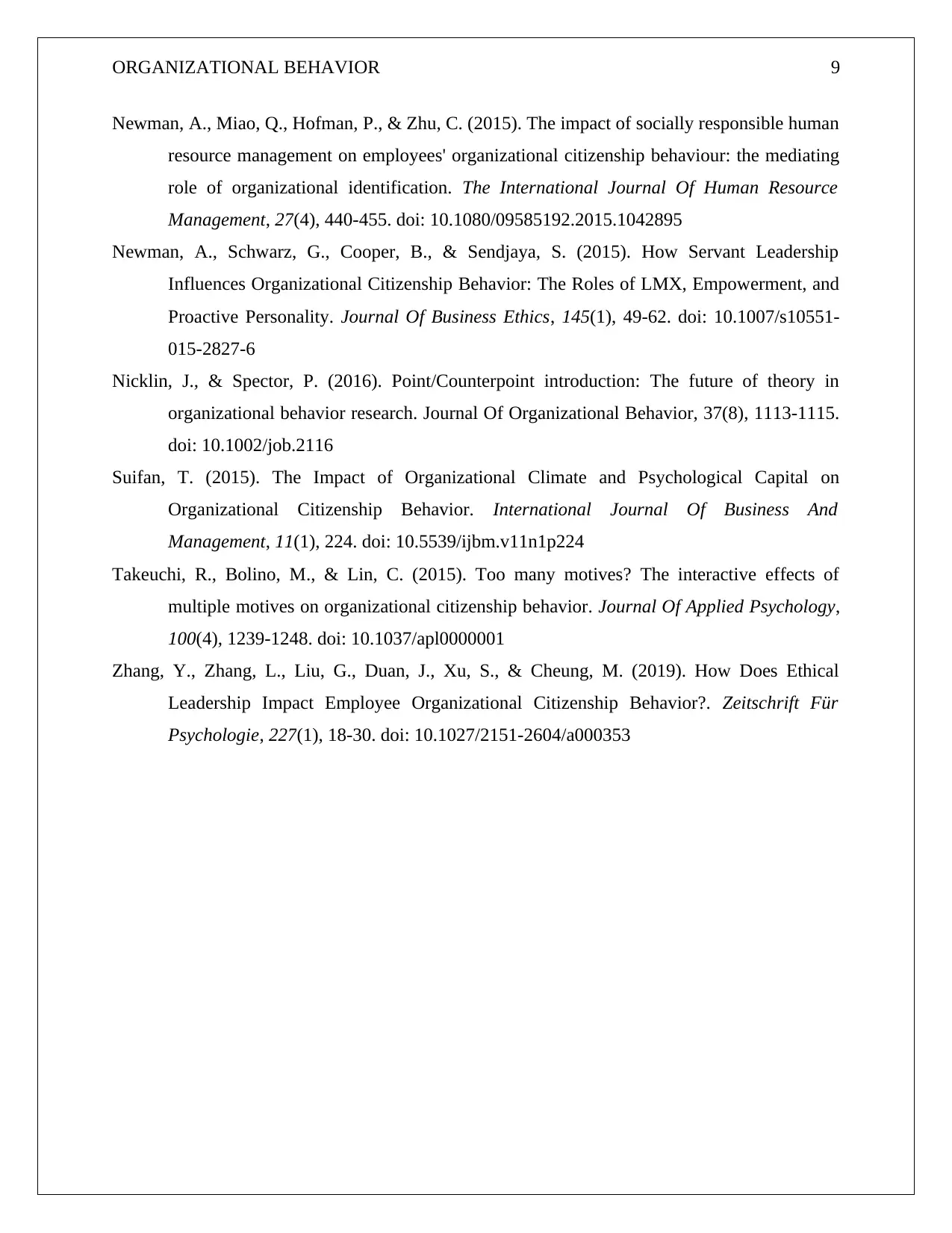
ORGANIZATIONAL BEHAVIOR 9
Newman, A., Miao, Q., Hofman, P., & Zhu, C. (2015). The impact of socially responsible human
resource management on employees' organizational citizenship behaviour: the mediating
role of organizational identification. The International Journal Of Human Resource
Management, 27(4), 440-455. doi: 10.1080/09585192.2015.1042895
Newman, A., Schwarz, G., Cooper, B., & Sendjaya, S. (2015). How Servant Leadership
Influences Organizational Citizenship Behavior: The Roles of LMX, Empowerment, and
Proactive Personality. Journal Of Business Ethics, 145(1), 49-62. doi: 10.1007/s10551-
015-2827-6
Nicklin, J., & Spector, P. (2016). Point/Counterpoint introduction: The future of theory in
organizational behavior research. Journal Of Organizational Behavior, 37(8), 1113-1115.
doi: 10.1002/job.2116
Suifan, T. (2015). The Impact of Organizational Climate and Psychological Capital on
Organizational Citizenship Behavior. International Journal Of Business And
Management, 11(1), 224. doi: 10.5539/ijbm.v11n1p224
Takeuchi, R., Bolino, M., & Lin, C. (2015). Too many motives? The interactive effects of
multiple motives on organizational citizenship behavior. Journal Of Applied Psychology,
100(4), 1239-1248. doi: 10.1037/apl0000001
Zhang, Y., Zhang, L., Liu, G., Duan, J., Xu, S., & Cheung, M. (2019). How Does Ethical
Leadership Impact Employee Organizational Citizenship Behavior?. Zeitschrift Für
Psychologie, 227(1), 18-30. doi: 10.1027/2151-2604/a000353
Newman, A., Miao, Q., Hofman, P., & Zhu, C. (2015). The impact of socially responsible human
resource management on employees' organizational citizenship behaviour: the mediating
role of organizational identification. The International Journal Of Human Resource
Management, 27(4), 440-455. doi: 10.1080/09585192.2015.1042895
Newman, A., Schwarz, G., Cooper, B., & Sendjaya, S. (2015). How Servant Leadership
Influences Organizational Citizenship Behavior: The Roles of LMX, Empowerment, and
Proactive Personality. Journal Of Business Ethics, 145(1), 49-62. doi: 10.1007/s10551-
015-2827-6
Nicklin, J., & Spector, P. (2016). Point/Counterpoint introduction: The future of theory in
organizational behavior research. Journal Of Organizational Behavior, 37(8), 1113-1115.
doi: 10.1002/job.2116
Suifan, T. (2015). The Impact of Organizational Climate and Psychological Capital on
Organizational Citizenship Behavior. International Journal Of Business And
Management, 11(1), 224. doi: 10.5539/ijbm.v11n1p224
Takeuchi, R., Bolino, M., & Lin, C. (2015). Too many motives? The interactive effects of
multiple motives on organizational citizenship behavior. Journal Of Applied Psychology,
100(4), 1239-1248. doi: 10.1037/apl0000001
Zhang, Y., Zhang, L., Liu, G., Duan, J., Xu, S., & Cheung, M. (2019). How Does Ethical
Leadership Impact Employee Organizational Citizenship Behavior?. Zeitschrift Für
Psychologie, 227(1), 18-30. doi: 10.1027/2151-2604/a000353
⊘ This is a preview!⊘
Do you want full access?
Subscribe today to unlock all pages.

Trusted by 1+ million students worldwide

ORGANIZATIONAL BEHAVIOR 10
1 out of 10
Related Documents
Your All-in-One AI-Powered Toolkit for Academic Success.
+13062052269
info@desklib.com
Available 24*7 on WhatsApp / Email
![[object Object]](/_next/static/media/star-bottom.7253800d.svg)
Unlock your academic potential
Copyright © 2020–2025 A2Z Services. All Rights Reserved. Developed and managed by ZUCOL.





